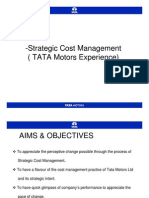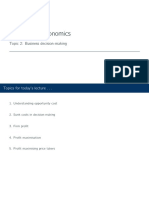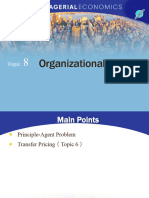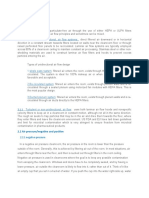Lecture Notes - Optimisation
Lecture Notes - Optimisation
Uploaded by
applefounderCopyright:
Available Formats
Lecture Notes - Optimisation
Lecture Notes - Optimisation
Uploaded by
applefounderOriginal Title
Copyright
Available Formats
Share this document
Did you find this document useful?
Is this content inappropriate?
Copyright:
Available Formats
Lecture Notes - Optimisation
Lecture Notes - Optimisation
Uploaded by
applefounderCopyright:
Available Formats
Lecture Notes
Optimisation
Optimisation Application Areas
Optimisation is nothing but utilisation of the resources at hand in the best possible manner. Because of its
ubiquitous nature, it is an indispensable tool in businesses and finds application in the following areas:
• Minimising cost
• Maximising profit
• Minimising error
• Design optimisation
• Management optimization
Some of the relevant industry examples where optimization is used are:
• Google AdWords bidding
• Airlines revenue management
• Project estimate based on NPV (Net Present Value)
Optimisation Terminologies
You learnt about the following terms related to optimisation:
• Objective Function: It essentially explains the entity that we want to maximise or minimise as per
the given business situation.
• Decision Variables: These are the quantities that the decision-makers control to optimise the
objective function.
• Constraints: These are the restrictions that we put on the decision variables to limit the values that
they can take.
• Sensitivity Analysis: It is a comparison of the different optimal solutions that you would obtain for
different constraints.
Optimisation in Excel
Next, you solved a simple optimization problem using Excel.
© Copyright 2018. UpGrad Education Pvt. Ltd. All rights reserved
The problem at hand was that the airline company XYZ wanted to maximise its revenue for a particular
Delhi to Bangalore flight by allocating the regular and discounted seats judiciously. The prices of the tickets
are:
• Discounted: 1190 INR
• Regular (Non-Discounted): 3085 INR
Your objective function for this problem thus became 3085x + 1190y.
You saw that using the SUMPRODUCT() function, you could simply implement the function '3085x + 1190y'
in Excel.
The cells C6 and C7 contain the price of the regular and discounted tickets respectively. The cells E6 and E7
are the ones where we will fill in the seats that we decide to allocate in order to get the optimal revenue.
Basically, these cells are the decision variables, i.e., the variables that need to be changed to arrive at the
optimal solution.
Then you filled in the constraints in Excel in the following format of LHS, sign, and RHS.
Finally, once you had all the data in the Excel in a proper format, you input all this information in the Solver
as shown below.
© Copyright 2018. UpGrad Education Pvt. Ltd. All rights reserved
Finally, you saw how you can visualise the constraints and results of the graph.
© Copyright 2018. UpGrad Education Pvt. Ltd. All rights reserved
The yellow polygon highlights the feasible solution region in the graph. And in the graph below, the purple
line showcases the optimal solution.
Airline Revenue Optimisation – Sensitivity Analysis
You started off by performing a sensitivity analysis on the airline optimisation problem when marketing
came into the picture. You understood that even though you would get the optimal revenue by selling all the
tickets at a regular price, you wouldn't do it to lose out on a customer segment.
Next, you performed another sensitivity analysis - this time for different capacities. There you saw that the
166-seater gave you the maximum marginal revenue and the 218 seater gave you the maximum market share
(since its capacity is the highest) along with a decent marginal revenue. You then understood that based on
the business situation - increasing profitability or increasing the market share, you would make the
appropriate decision.
Finally, you saw another example of connecting flight where the flight from Delhi to Bangalore had a stop at
Mumbai and understood that the main skill to have while solving any optimisation problem is the ability to
define the objective function, identify the decision variables, and formulate the constraints.
© Copyright 2018. UpGrad Education Pvt. Ltd. All rights reserved
You should be able to:
• Understand the terminologies related to optimisation
• Understand the objective function, identify the decision variables, and formulate the constraints for
any optimisation problem at hand
• Solve the optimisation problem in Excel using the Solver Add-in
© Copyright 2018. UpGrad Education Pvt. Ltd. All rights reserved
Disclaimer: All content and material on the UpGrad website is copyrighted material, either belonging to UpGrad or
its bonafide contributors and is purely for the dissemination of education. You are permitted to access print and
download extracts from this site purely for your own education only and on the following basis:
● You can download this document from the website for self-use only.
● Any copies of this document, in part or full, saved to disc or to any other storage medium may only be used
for subsequent, self-viewing purposes or to print an individual extract or copy for non-commercial personal
use only.
● Any further dissemination, distribution, reproduction, copying of the content of the document herein or the
uploading thereof on other websites or use of content for any other commercial/unauthorized purposes in
any way which could infringe the intellectual property rights of UpGrad or its contributors, is strictly
prohibited.
● No graphics, images or photographs from any accompanying text in this document will be used separately
for unauthorised purposes.
● No material in this document will be modified, adapted or altered in any way.
● No part of this document or UpGrad content may be reproduced or stored in any other web site or included
in any public or private electronic retrieval system or service without UpGrad’s prior written permission.
● Any rights not expressly granted in these terms are reserved.
© Copyright 2018. UpGrad Education Pvt. Ltd. All rights reserved
You might also like
- NI - 43 - 101 - Solwara - Deep Sea Mining PDFDocument227 pagesNI - 43 - 101 - Solwara - Deep Sea Mining PDFCarlos A. Espinoza MNo ratings yet
- Conceptual Enterprise Asset Management For Plant Construction ProcessDocument25 pagesConceptual Enterprise Asset Management For Plant Construction ProcessYong Benedict100% (1)
- Strategic Cost ManagementDocument27 pagesStrategic Cost ManagementKnt Nallasamy GounderNo ratings yet
- Develop An Enterprise Architecture VisionDocument61 pagesDevelop An Enterprise Architecture VisionFoxman2k100% (1)
- 61 Point Relaxation TechniqueDocument7 pages61 Point Relaxation Techniquesaintx100% (1)
- Session Summary Investment DecisionsDocument9 pagesSession Summary Investment Decisionsurmila ranaNo ratings yet
- Summary+Document +Operating+Working+CapitalDocument5 pagesSummary+Document +Operating+Working+CapitalHarsh SinghalNo ratings yet
- Assignment of QTDocument9 pagesAssignment of QTAli AhmadNo ratings yet
- Session Summary Valuation of EquityDocument6 pagesSession Summary Valuation of Equityurmila ranaNo ratings yet
- Transcript +Course+OverviewDocument2 pagesTranscript +Course+Overviewdharish.theetiahNo ratings yet
- Day 2Document82 pagesDay 2ahmed hassanNo ratings yet
- IT Initiative ROI Tool-NmDocument30 pagesIT Initiative ROI Tool-NmBobbyNichols100% (1)
- Session Summary Valuation of EnterpriseDocument10 pagesSession Summary Valuation of Enterpriseurmila ranaNo ratings yet
- Practice Material_Leading Gen AI TransformationDocument6 pagesPractice Material_Leading Gen AI Transformationsuryaswaroop161No ratings yet
- QuestionsDocument2 pagesQuestionsRza Rustamli0% (2)
- Topic 2 - Business Decision-MakingDocument37 pagesTopic 2 - Business Decision-MakingSunny XuNo ratings yet
- Costsheetoftatamotors 230506154745 Eceed448Document14 pagesCostsheetoftatamotors 230506154745 Eceed4482526avnishNo ratings yet
- 2013 FSAE Business Logic CaseDocument5 pages2013 FSAE Business Logic CasejavigpascualNo ratings yet
- GigaDocument13 pagesGigagudikotisNo ratings yet
- Forrester Total Economic Impact ReportDocument30 pagesForrester Total Economic Impact ReportMaster BionickNo ratings yet
- Business+Problem+Solving +Lecture+NotesDocument5 pagesBusiness+Problem+Solving +Lecture+Notessamrat141988No ratings yet
- Buyer's Checklist: How To Find A Solution That Delivers Fast ROIDocument6 pagesBuyer's Checklist: How To Find A Solution That Delivers Fast ROIImmanuel HenneNo ratings yet
- Kuliah 5Document32 pagesKuliah 5Kevin MuhammadNo ratings yet
- Naukri JayPatel (3y 0m)Document1 pageNaukri JayPatel (3y 0m)jyotsna.uNo ratings yet
- Techniques For Enhancing Long-Term ProfitsDocument52 pagesTechniques For Enhancing Long-Term ProfitsBingqing FEINo ratings yet
- Consummer and Producer TheoryDocument7 pagesConsummer and Producer TheoryAlpesh KhilariNo ratings yet
- 11 Stock Valuation and RiskDocument44 pages11 Stock Valuation and RiskPaula Ella BatasNo ratings yet
- WWT-IIMC Trilytics Conclave Presentation TemplateDocument9 pagesWWT-IIMC Trilytics Conclave Presentation Templateapmapm171No ratings yet
- Session Summary - Data To Decisions FrameworkDocument4 pagesSession Summary - Data To Decisions FrameworkARCHANA GAIKWADNo ratings yet
- Charles W. L. Hill / Gareth R. JonesDocument25 pagesCharles W. L. Hill / Gareth R. JonesSamNo ratings yet
- Global Challenge IntroductionDocument40 pagesGlobal Challenge IntroductionSam RightNo ratings yet
- ExerciseDocument126 pagesExercisemanasaNo ratings yet
- Chapter 7Document26 pagesChapter 7Devasena SNo ratings yet
- TEMPLATE Presentation - Offer For PartnersDocument55 pagesTEMPLATE Presentation - Offer For Partnersjoel nugrohoNo ratings yet
- 12 Must-Have Marketing Analytics Tools of 2024 (Free & Paid)Document6 pages12 Must-Have Marketing Analytics Tools of 2024 (Free & Paid)toolanalytics6No ratings yet
- CRM Evaluation GuideDocument18 pagesCRM Evaluation GuideRamon RinconesNo ratings yet
- Transcription+Module+Summary Docx+Document4 pagesTranscription+Module+Summary Docx+urmila ranaNo ratings yet
- Cost Analysis HeroDocument81 pagesCost Analysis HeroNagireddy Kalluri0% (1)
- Enterprise+Risk+Management+FrameworksDocument8 pagesEnterprise+Risk+Management+FrameworksJitu BeheraNo ratings yet
- INS3032 Chap 1Document45 pagesINS3032 Chap 1Lan Hương VũNo ratings yet
- Jurnal Tugas Kasus Linier ProgramingDocument5 pagesJurnal Tugas Kasus Linier ProgramingMuchammad Miftachul HudaNo ratings yet
- Portals 10... Hallenge Guide BookDocument41 pagesPortals 10... Hallenge Guide BookBuzz MornauNo ratings yet
- Decision Making Models in Project ManagementDocument6 pagesDecision Making Models in Project ManagementKUNAL PATELNo ratings yet
- CIMA Paper E2: NotesDocument16 pagesCIMA Paper E2: NotesWYNBADNo ratings yet
- Extending The Lean Enterprise: February 2008Document21 pagesExtending The Lean Enterprise: February 2008Tiotet33No ratings yet
- Topic 8Document50 pagesTopic 8gupeibin462No ratings yet
- Gojek Case StudyDocument15 pagesGojek Case StudyRicky PrasojoNo ratings yet
- FinalGCSASolution Set1Document44 pagesFinalGCSASolution Set1jeet_singh_deepNo ratings yet
- !QVM6MA0294C8TopTenRisksDocument21 pages!QVM6MA0294C8TopTenRiskssugarholaNo ratings yet
- Senior System Architect: Advanced Topics: 8. 3 Exercise GuideDocument36 pagesSenior System Architect: Advanced Topics: 8. 3 Exercise GuideArneMagnussonNo ratings yet
- Business+Problem+Solving +Lecture+NotesDocument5 pagesBusiness+Problem+Solving +Lecture+NotesAdit PaliwalNo ratings yet
- Topic 5 - Improving BPM With Operational Decision ManagementDocument5 pagesTopic 5 - Improving BPM With Operational Decision ManagementsarahnicolejaconesbarsubiaNo ratings yet
- Chapter 7Document31 pagesChapter 7Bharath WarajNo ratings yet
- XGBoost - A Powerful Machine Learning Algorithm For BeginnersDocument3 pagesXGBoost - A Powerful Machine Learning Algorithm For BeginnersRahul singhNo ratings yet
- Summary+Doc+-+IMT+15 3 1Document9 pagesSummary+Doc+-+IMT+15 3 1Sankaran PichumaniNo ratings yet
- 2012 Capstone Team Member GuideDocument28 pages2012 Capstone Team Member GuideZabi MahammadNo ratings yet
- Question Responses (2022-10-06)Document5 pagesQuestion Responses (2022-10-06)monde lyitaNo ratings yet
- A Model-Based Framework: An Approach For Profit-Driven OptimizationDocument11 pagesA Model-Based Framework: An Approach For Profit-Driven OptimizationSyakirah AzlanNo ratings yet
- IBM TRIRIGA Leased And Owned Property Contract Management A Complete Guide - 2020 EditionFrom EverandIBM TRIRIGA Leased And Owned Property Contract Management A Complete Guide - 2020 EditionNo ratings yet
- The Real Value of Training: Measuring and Analyzing Business Outcomes and the Quality of ROIFrom EverandThe Real Value of Training: Measuring and Analyzing Business Outcomes and the Quality of ROINo ratings yet
- Writing Compelling Business Cases: Methods, Tools and Templates for Writing and Presenting a Brilliant Business CaseFrom EverandWriting Compelling Business Cases: Methods, Tools and Templates for Writing and Presenting a Brilliant Business CaseNo ratings yet
- The Audio Codec: Stereo and Huffman CodingDocument6 pagesThe Audio Codec: Stereo and Huffman CodingapplefounderNo ratings yet
- Phases of NLP (8 Files Merged)Document66 pagesPhases of NLP (8 Files Merged)applefounderNo ratings yet
- Image Compression Using Huffman Coding - GeeksforGeeksDocument42 pagesImage Compression Using Huffman Coding - GeeksforGeeksapplefounderNo ratings yet
- Huffman Code - Brilliant Math & Science WikiDocument18 pagesHuffman Code - Brilliant Math & Science WikiapplefounderNo ratings yet
- Huffman Coding Technique For Image Compression: ISSN:2320-0790Document3 pagesHuffman Coding Technique For Image Compression: ISSN:2320-0790applefounderNo ratings yet
- Huffman Coding - Greedy Algo-3 - GeeksforGeeksDocument38 pagesHuffman Coding - Greedy Algo-3 - GeeksforGeeksapplefounderNo ratings yet
- Image Compression Using Huffman Coding - GeeksforGeeksDocument42 pagesImage Compression Using Huffman Coding - GeeksforGeeksapplefounderNo ratings yet
- Engineering Physics NotesDocument40 pagesEngineering Physics NotesapplefounderNo ratings yet
- Silviculture (2020)Document90 pagesSilviculture (2020)salman khalilNo ratings yet
- Amit Bhardwaj CVDocument3 pagesAmit Bhardwaj CVAmit BhardwajNo ratings yet
- Spine: Essential Neurosurgery For Medical StudentsDocument29 pagesSpine: Essential Neurosurgery For Medical StudentsAndreea IduNo ratings yet
- Edu 490 Professional Development PlanDocument2 pagesEdu 490 Professional Development Planapi-487264930No ratings yet
- Computer Aided Machine DrawingDocument8 pagesComputer Aided Machine DrawingLankipalli HemanthNo ratings yet
- How To Get A Verified Paypal AccountsDocument1 pageHow To Get A Verified Paypal AccountsPrajeesh KrishnanNo ratings yet
- Basic Requirements For Clean RoomDocument6 pagesBasic Requirements For Clean Roomsamuel debebeNo ratings yet
- Biology ReviewerDocument1 pageBiology ReviewerKevin OnaroNo ratings yet
- EMS COVER pagesDocument7 pagesEMS COVER pagesojgamingyt19No ratings yet
- Cresta, Joseph ResumeDocument1 pageCresta, Joseph Resumewilliam schwartzNo ratings yet
- Module B Kaial16 PDFDocument68 pagesModule B Kaial16 PDFMohamad Abu BakarNo ratings yet
- Edexcel Igcse Biology Book StudentDocument36 pagesEdexcel Igcse Biology Book Studentrasanmzuri208No ratings yet
- TDA DesignManual Volume2 14decDocument36 pagesTDA DesignManual Volume2 14decvaranasirk1No ratings yet
- IBM Achieves CMMI Level Three Certification Through Hard Work and A Team EffortDocument2 pagesIBM Achieves CMMI Level Three Certification Through Hard Work and A Team EffortMurat KalenderNo ratings yet
- Posterior Urethral Valves (PUV) - Children's Hospital of Philadelphia PDFDocument4 pagesPosterior Urethral Valves (PUV) - Children's Hospital of Philadelphia PDFAndri Feisal Nasution100% (1)
- SNMPDRV Installation InstructionsDocument3 pagesSNMPDRV Installation InstructionsgmawoyoNo ratings yet
- CalcaneusDocument4 pagesCalcaneusMediaWalesGRNo ratings yet
- Empowerment Technologies ReviewerDocument3 pagesEmpowerment Technologies Reviewerۦۦ RhoanNo ratings yet
- Gabriela Tanase: (Architect)Document25 pagesGabriela Tanase: (Architect)Sasha Gabriela TanaseNo ratings yet
- Simple Operation, Easy As 1-2-3: Vetscan Hm5 Less Time, Less Sample, More Accuracy, More ReproducibilityDocument6 pagesSimple Operation, Easy As 1-2-3: Vetscan Hm5 Less Time, Less Sample, More Accuracy, More ReproducibilityglenniesamuelNo ratings yet
- Arduino Security and Alarm System Project How To MechatronicsDocument55 pagesArduino Security and Alarm System Project How To MechatronicsYAVANA BNo ratings yet
- GTA San Andreas CheatsDocument2 pagesGTA San Andreas CheatskhanNo ratings yet
- Esgd 3Document279 pagesEsgd 3JOSHUA MEDRANONo ratings yet
- G19+G510 Backlight Colour-Cycling ScriptDocument4 pagesG19+G510 Backlight Colour-Cycling ScriptAlexNo ratings yet
- NEoWave S&PDocument1 pageNEoWave S&PshobhaNo ratings yet
- Delhi Architects - List of Architects in DelhiDocument81 pagesDelhi Architects - List of Architects in DelhiPriyan SoodNo ratings yet
- Media and Entertainment Industry in IndiaDocument29 pagesMedia and Entertainment Industry in IndiaPallavi MukkamalaNo ratings yet
- RaisesDocument75 pagesRaiseszakaria elNo ratings yet
































































































